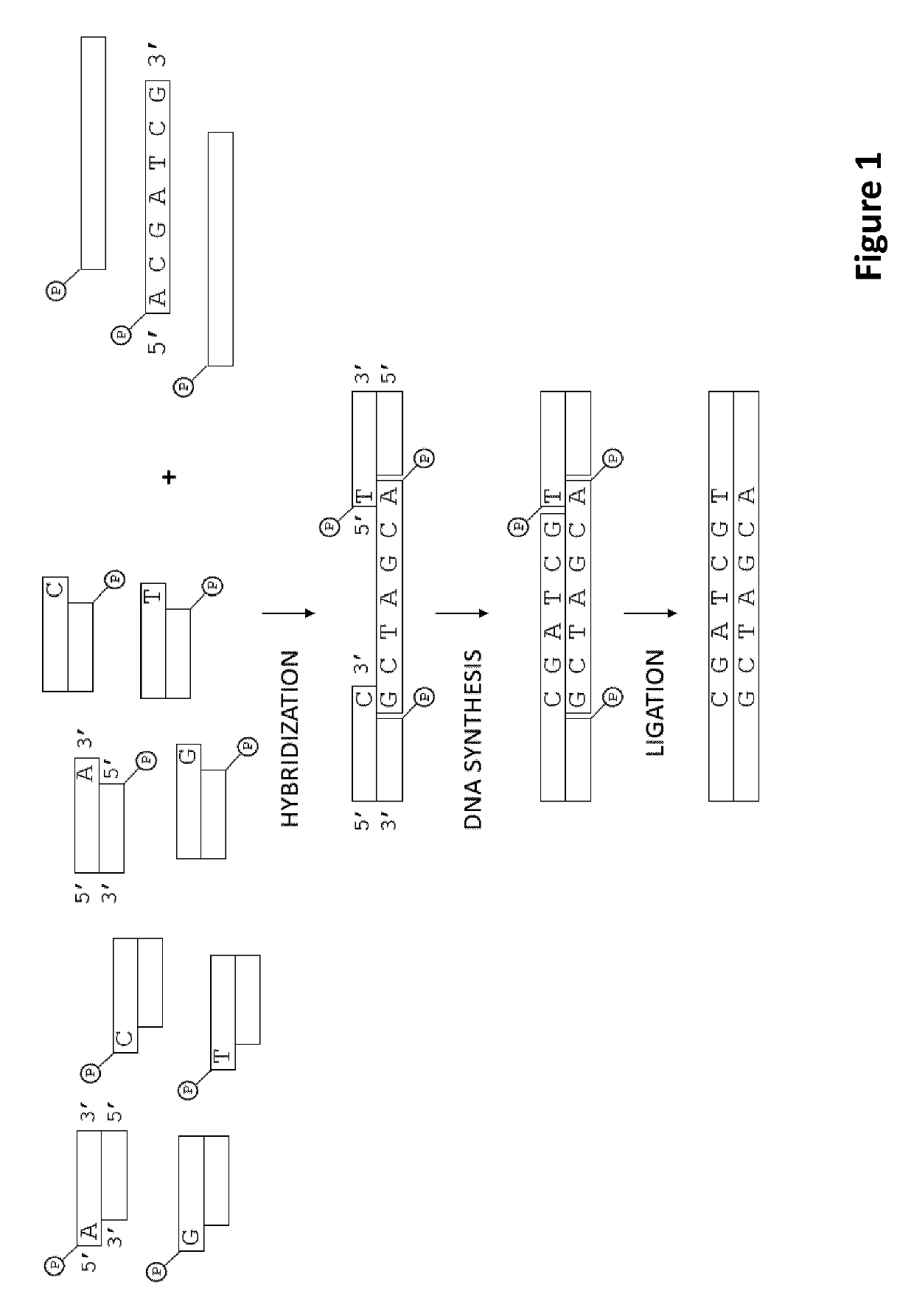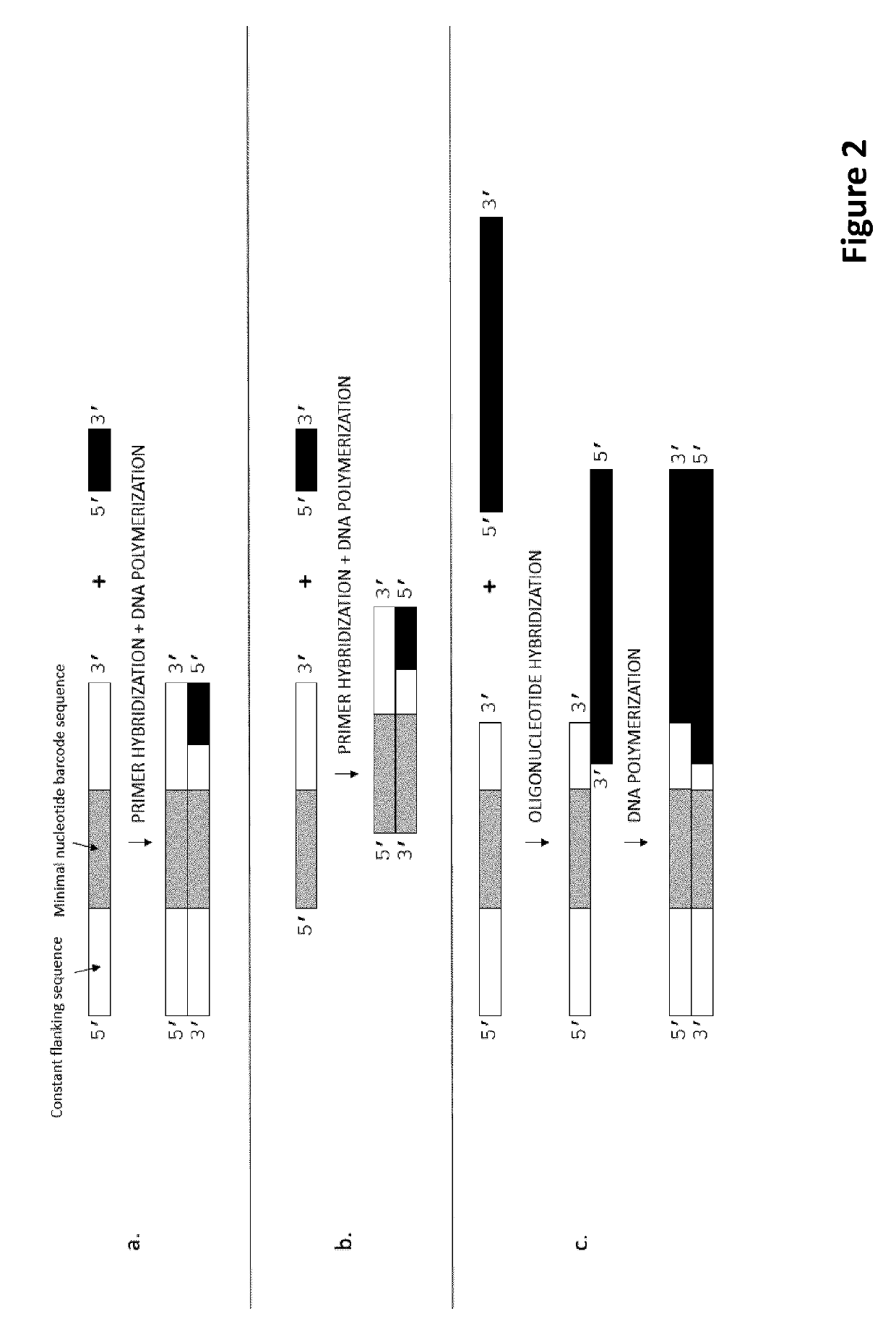Methods for identification of samples
a technology for identifying samples and samples, applied in bio laboratory glassware, chemistry apparatus and processes, etc., can solve problems such as inability to identifie items with a printed barcode label, prone to errors in most processes, and inability to prevent errors
- Summary
- Abstract
- Description
- Claims
- Application Information
AI Technical Summary
Benefits of technology
Problems solved by technology
Method used
Image
Examples
example 1
ansferable Molecular Identification Barcodes in an NGS
[0264]For illustrative means, FIG. 7 shows how the use of transferable molecular identification barcodes in an NGS assay using a 2-step PCR protocol for enrichment of the target regions of nucleic acids under investigation will detect a sample switch or contamination.
[0265]A transferable molecular identification barcode was added to patient samples, of which two target nucleic acid regions A and B are of interest. By a two-step multiplex PCR protocol, the two target nucleic acid regions and the minimal nucleotide barcode and its flanking sequences of the transferable molecular identification barcode are amplified. For this purpose, amplicon-specific primers directed to primer binding sites flanking all 3 target nucleic acids regions are amplified. All the amplicon-specific primers carry a 5′ universal adapter sequence (one type of universal adapter sequence for the forward primers and another type of universal adapter sequence fo...
example 2
est Workflows
[0267]FIG. 8 shows a workflow in a genetic test, starting from a blood collector tube that contains transferable molecular identification barcode to a final valid genetic test report.
[0268]A blood collector tube contains a unique transferable molecular identification barcode and a one to one linked optical macroscopic barcode label. The unique molecular identification barcode and optical barcodes, and their one to one link, are stored in a database, which is accessible through the cloud. From a patient, blood is collected in this blood collector tube. To this blood collector tube another (second) optical barcode paper label from the patient (e.g. generated by the hospital) is attached so that the blood collector tube now has two optical barcode paper labels attached. When the patient optical barcode label is linked to a LIMS system, and when both optical barcode paper labels are scanned, the information of the first optical barcode label becomes also connected to the LI...
example 3
Sample Testing Process at Different Subprocesses with Transferable Molecular Identification Barcodes
[0272]FIG. 11 shows two samples that are labelled with transferable molecular identification barcodes when the blood is taken. Blood sample 1 is labeled with transferable molecular identification barcode 1, blood sample 2 is labeled with transferable molecular identification barcode 2, The DNA of both samples is extracted in a DNA extraction facility. Then, the extracted DNA samples are again labelled with transferable molecular identification barcodes. DNA sample 1 is labeled with transferable molecular identification barcode A, DNA sample 2 is labeled with transferable molecular identification barcode B. The DNA samples are then sent to a next generation sequencing facility. The transferable molecular identification barcodes respectively used for labelling blood or DNA are built up of nucleotide barcodes that have respectively different nucleotide barcode sequence identifier sequenc...
PUM
| Property | Measurement | Unit |
|---|---|---|
| Tm | aaaaa | aaaaa |
| temperature | aaaaa | aaaaa |
| Tm | aaaaa | aaaaa |
Abstract
Description
Claims
Application Information
 Login to View More
Login to View More - R&D
- Intellectual Property
- Life Sciences
- Materials
- Tech Scout
- Unparalleled Data Quality
- Higher Quality Content
- 60% Fewer Hallucinations
Browse by: Latest US Patents, China's latest patents, Technical Efficacy Thesaurus, Application Domain, Technology Topic, Popular Technical Reports.
© 2025 PatSnap. All rights reserved.Legal|Privacy policy|Modern Slavery Act Transparency Statement|Sitemap|About US| Contact US: help@patsnap.com



